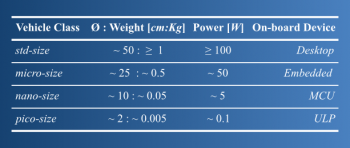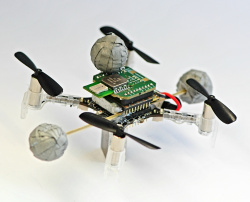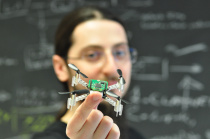Energy Efficient Autonomous UAVs
From iis-projects
Contents
Topic
The interest in autonomous vehicles is growing constantly, with lots of practical applications appearing on the marketplace and many more being actively studied in academia, industry and military research departments. Two of the most representative examples of such technology are unmanned aerial vehicles (UAVs) and autonomous driving systems. Autonomous systems are emerging in many fields in order to assist and help humans in a plethora of applications, like environment surveillance/inspection, etc. Fully autonomous driving is still out of reach, but virtually every major OEM (BMW, Volvo, Tesla Motors, GM) has a clear roadmap towards achieving this goal and is already commercializing advanced driver assistance systems (ADAS). Autonomous vehicles represent a unique opportunity to effectively handle critical and expensive activities, compared to the traditional use of human operators only. Autonomous UAVs are adopted for periodic tasks of inspection, like dyke inspection aimed to find cracks on the wall, nuclear plant control or cultivated field monitoring.
To obtain such sophisticated and useful systems, advanced capabilities and cognitive skills are required. Depending on the specific use case, the desired autonomous navigation capability is reached by combining one or more basic computational tasks. Widely adopted tasks, such as obstacle avoidance, path planning, target/pedestrian detection, simultaneous localization, and mapping, etc, are very complex and computationally intensive. Given the high computational requirements that such workloads expose, current state-of-the-art solutions need quite powerful computational units. The typical class of devices used for such sophisticated algorithms are multi-cores high-end CPUs and embedded heterogeneous systems featuring powerful CPUs coupled with many-core accelerators (e.g. GPUs). In both classes, the order of magnitude for the power consumption is in the range of few Watts to tens of Watts.
Such computational requirements, and power budget, limit the applicability of such techniques to vehicles that expose enough power for the computation. If we consider for instance rotorcraft or flapping-wings UAVs, the available power budget for computation is between 5-20% of the overall power. Thus, reducing the power consumption of the control system in UAVs will become increasingly important as the size of the vehicle is scaled down. Indeed, reducing the UAV size quickly leads to an order-of-magnitude reduction of the power spent on the propellers. Besides, the computational load required to implement the UAV cognitive skills does not vary with the vehicle size, and will thus constitute an increasingly larger fraction of the total system power consumption.
Nano-size Quadrotor
Our first cyber-physical platform is the nano-size Bitcraze CrazyFlie 2.1 [1]. It has been used in many projects due to its dimension, versatility, and its open-source and open-hardware nature. Nowadays is well known how UAVs with high-level autonomous navigation capabilities are a hot topic both in industry and academia due to their numerous applications. However, autonomous navigation algorithms are demanding from a computational standpoint, and it is very challenging to run them on-board of nano-scale UAVs (i.e., few centimeters of diameter) because of the limited capabilities of their MCU-based controllers. The nano-quadrotor is an appealing platform (among others) for addressing this challenging task. In this context, we presented a lightweight hardware-software solution, bringing autonomous navigation on a commercial platform using only onboard computational resources. Furthermore, we evaluated how the Parallel Ultra-Low-Power Platform [2] can enable running sophisticated machine learning algorithms for achieving autonomous navigation or localization capabilities.
Contact Information
Hanna Mueller
- e-mail: hanmuell@iis.ee.ethz.ch
- phone: +41 44 633 84 17
- address: Gloriastrasse 35, 8092 Zürich
- office: ETZ J76.2
Vlad Niculescu
- e-mail: vladn@iis.ee.ethz.ch
- address: Gloriastrasse 35, 8092 Zürich
- office: ETZ J68.1
Daniele Palossi
- e-mail: dpalossi@iis.ee.ethz.ch
- phone: +41 44 633 88 43
- address: Gloriastrasse 35, 8092 Zürich
- office: ETZ J76.2
Collaborations
We are pleased to inform our students that we have the opportunity to offer co-supervised Master/Semester Thesis on the Autonomous UAVs topic in collaborations with other top-quality research groups like:
- TIK: The Computer Engineering and Networks Laboratory - ETH Zürich - Web Site
- RPG: Robotic and Perception Group - University of Zürich - Web Site
- MICREL: Microelectronics Laboratory - University of Bologna - Web Site
Projects
We are listing a few projects below to give you an idea of what we do. However, we constantly have new project ideas and maybe some other approaches become obsolete in the very rapidly advancing research area. Please just contact us and come to talk with us.
Available Projects
- Event-based navigation on autonomous nano-drones
- A Novel Execution Scheme for Ultra-tiny CNNs Aboard Nano-UAVs
- Improved Collision Avoidance for Nano-drones
- Deep Learning-based Global Local Planner for Autonomous Nano-drones
- Monocular Vision-based Object Following on Nano-size Robotic Blimp
- A Waypoint-based Navigation System for Nano-Size UAVs in GPS-denied Environments
- Covariant Feature Detector on Parallel Ultra Low Power Architecture
Projects In Progress
Completed Projects
- Improved State Estimation on PULP-based Nano-UAVs
- Towards Self-Sustainable Unmanned Aerial Vehicles
- Study and Development of Intelligent Capability for Small-Size UAVs
- Towards Autonomous Navigation for Nano-Blimps
- PULP-Shield for Autonomous UAV
- Self-Learning Drones based on Neural Networks
Publications
The group effort and the great contribution from the students of last few years has resulted in the following list of publications:
- 2018 - D. Palossi et Al., "Extending the Lifetime of Nano-Blimps via Dynamic Motor Control", Springer Journal of Signal Processing Systems (Springer JSPS), 2018 - On-line
- 2017 - D. Palossi et Al., "Target Following on Nano-Scale Unmanned Aerial Vehicles", 7th IEEE International Workshop on Advances in Sensors and Interfaces, June 15-16, Vieste, Italy, 2017 - On-line
- 2017 - B. Forsberg et Al., "GPU-Accelerated Real-Time Path Planning and the Predictable Execution Model", International Conference on Computational Science (ICCS), June 12-14, Zürich, Switzerland, 2017 - On-line
- 2017 - D. Palossi et Al., "On the Accuracy of Near-Optimal CPU-Based Path Planning for UAVs", 20th International Workshop on Software and Compilers for Embedded Systems (SCOPES), June 12-13, Sankt Goar, Germany, 2017 - On-line
- 2017 - D. Palossi et Al., "Self-sustainability in Nano Unmanned Aerial Vehicles: A Blimp Case Study", Computing Frontiers (CF), May 15-17, Siena, Italy, 2017 - On-line
- 2017 - D. Palossi et Al., "Ultra Low-Power Visual Odometry for Nano-Scale Unmanned Aerial Vehicles", Design, Automation and Test in Europe (DATE), March 27-31, Lausanne, Switzerland, 2017 - On-line
- 2016 - D. Palossi et Al., "Exploring Single Source Shortest Path Parallelization on Shared Memory Accelerator", 19th International Workshop on Software and Compilers for Embedded Systems (SCOPES), May 23-25, Sankt Goar, Germany, 2016 - On-line
- 2016 - D. Palossi et Al., "An Energy-Efficient Parallel Algorithm for Real-Time Near-Optimal UAV Path Planning", 2nd Workshop on Design of Low Power Embedded Systems (LP-EMS), May 16-18, Como, Italy, 2016 - On-line
- 2016 - F. Conti et Al., "Enabling the Heterogeneous Accelerator Model on Ultra-Low Power Microcontroller Platforms", Design, Automation and Test in Europe (DATE), March 14-18, Dresden, Germany, 2016 - On-line



